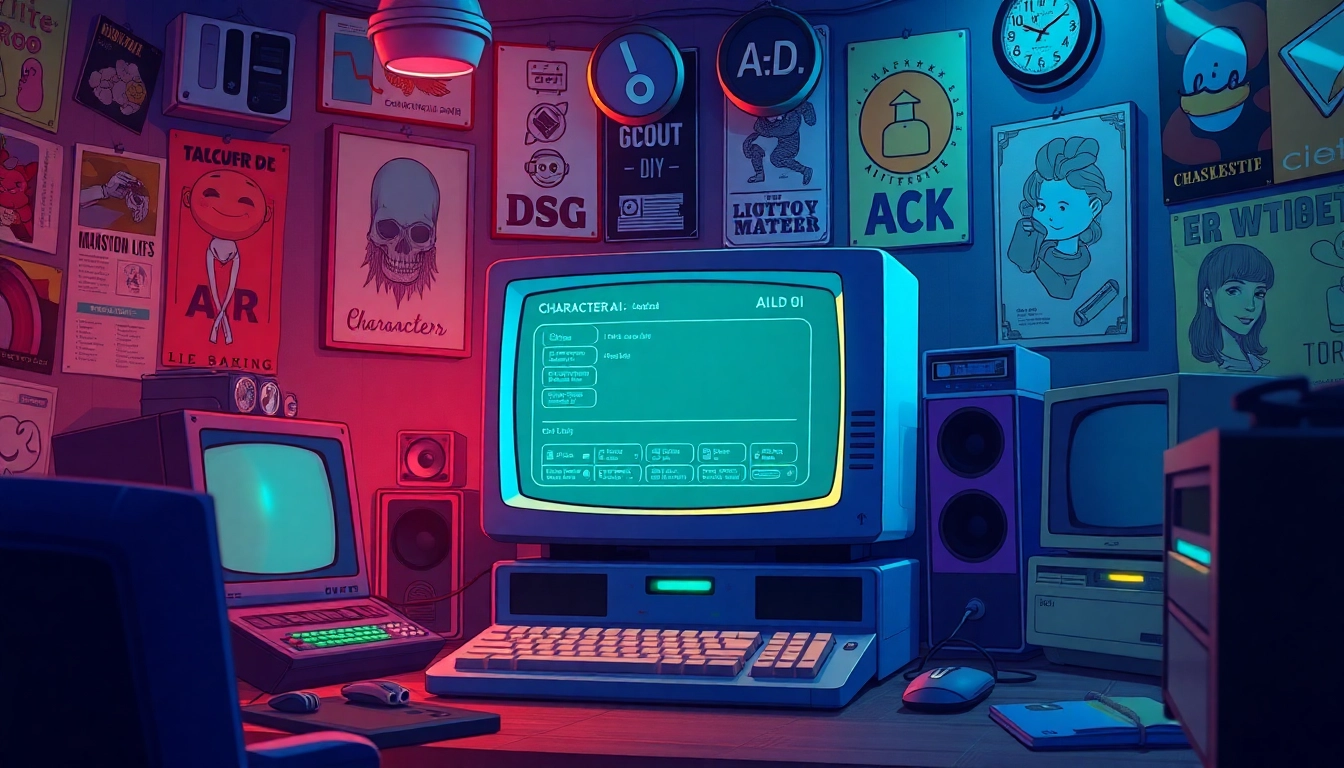The Rise of Character AI: Understanding Its Evolution
Overview of Character AI Development
The advent of Character AI marks a significant milestone in the landscape of artificial intelligence, shifting the way users engage with technology. Developed as an immersive platform for interaction, Character AI began as a simple chatbot service designed to produce human-like responses. Over time, it has evolved into a sophisticated tool capable of maintaining contextual conversations and personalizing interactions based on user preferences. This evolution is defined by its transformational algorithms and the increasing complexity of its language processing abilities, allowing for more nuanced dialogue compared to earlier AI models.
Key Features of Character AI Old
The original version of Character AI, often referred to as Character AI Old, introduced several features that distinguished it from its predecessors. Users appreciated the straightforwardness and functionality that catered to casual interaction. Notable features included an intuitive user interface, easy prompt setups, and the ability to create and engage with various characters seamlessly. The platform’s charm was underscored by personal storytelling where characters could adaptively respond to users, creating a sense of connection and engagement that has become rare in contemporary iterations. Many enthusiasts reflect on these traits nostalgically, indicating that they provided a more authentic interaction experience.
User Reactions to Changes
As Character AI has transitioned to newer versions, there have been mixed reactions among its user base. Many long-time users have expressed dissatisfaction with the removed features and perceived complexity of the updates. Social media and forums abound with discussions surrounding the changes, often with users wishing to revert to the simplicity and charm of the old version. This pushback demonstrates a common theme in technology: while evolution is crucial, the need for user satisfaction and comfort remains paramount. Evidence of this can be seen in various community posts and engagements lamenting the loss of Character AI’s old user experience.
Accessing Character AI Old: What You Need to Know
How to Download Older Versions
If you’re eager to experience the classic version of Character AI, several options are available to access older iterations. For Android users, a reliable method is to source an older APK (Android Package Kit) file. Websites such as character ai old can provide archives of prior versions, ensuring that you can enjoy a more familiar interface. When downloading older versions, it is crucial to be cautious and confirm that the site you are engaging with includes legitimate files to avoid malware.
Steps to Revert to Character AI Old
Reverting back to Character AI Old requires a few straightforward steps:
- First, uninstall the current version of Character AI from your device.
- Next, locate a secure website where older versions are hosted, such as Uptodown or similar trustworthy APK sites.
- Download the preferred older version of the app onto your device.
- Enable installations from unknown sources in your mobile settings to allow the APK file to be installed.
- Finally, install the downloaded APK and open Character AI, where you should find the familiar user interface.
By following these steps, users seeking a nostalgic return to Character AI’s simpler design can successfully regain access.
Common User Issues and Solutions
As users transition back to the old version of Character AI, several challenges may arise:
- Installation Errors: Users may encounter issues during installation if their device settings are not properly configured. Solution: Ensure that permissions for installations from unknown sources are enabled.
- App Crashes: Some users report that older versions may crash if the device’s software is too recent. Solution: Consider testing the APK on a device with a compatible Android version.
- Missing Features: Users may find that not all features from the new version are available in the old version. Solution: Familiarize yourself with the features retained in the old version to maximize its use.
Comparative Analysis: Character AI Old vs. New
User Interface Design: A Side-by-Side Review
The user interface (UI) of Character AI has undergone notable changes from its old version to the new iteration. The older design was characterized by its straightforward navigation, which catered to all user levels, making it accessible to novices and enthusiasts alike. Users often appreciated the simplicity of the layout, which allowed them to jump right into conversations without extensive tutorials or learning curves. In contrast, the newer UI incorporates a more sophisticated layout that, while visually appealing, has been criticized for its complexity and reliance on user guidance.
Capabilities and Limitations of Character AI Old
Character AI Old excelled in certain areas that set it apart from modern adaptations. Its ability to engage users through relatable character interactions fostered memorable experiences. Users reported enjoying the storytelling capabilities where characters could retain context across multiple conversations. However, limitations included a lack of advanced features, such as emotion modeling and deep learning capabilities present in the new version, which enable more complex dialogue constructs but at the cost of ease-of-use found in the older version.
Impact on User Experience
The evolution of Character AI directly impacts the user experience. While the move to modern technology has increased functionality, it has also introduced barriers for users accustomed to the previous setup. Many users now face a learning curve associated with understanding new navigation features and capabilities, leading to frustration. Conversely, those who embraced the upgrade often enjoy enhanced conversation depth and broader character selections, showcasing a divide between long-term enthusiasts favoring the past and new users embracing the present advancements.
Community Perspectives: Why Some Prefer Character AI Old
Nostalgia and Emotional Connections
Nostalgia plays a powerful role in the continued preference for Character AI Old among its user base. Many users, having invested significant time in interacting with characters from earlier versions, find it difficult to say goodbye to the simplicity and charm that characterized their experiences. Emotional connections formed during interactions foster a sense of attachment, prompting discussions centered on preserving those experiences. Furthermore, these conversations highlight broader trends where nostalgia drives user loyalty, as they favor a product that feels more aligned with their initial engagement with technology.
Discussions in Online Forums
Online forums serve as rich repositories of community opinions regarding Character AI Old. Users frequently share their experiences, provide tips on reverting versions, and express their feelings towards recent changes. Some theorize that the rapid changes aren’t resonating with users seeking continuity. Discussions often revolve around specific features lost in the transition and the emotional resonance of past interactions. This collective sentiment underscores the importance of engaging with communities that share similar experiences, facilitating dialogue among those who cherish the old version.
Comparing User Preferences
User preference trends frequently reveal a dichotomy in experiences based on usage length. Long-term users typically favor classics due to familiarity, while newer users may prefer strides in sophistication and depth found in recent updates. This divergence raises questions about market segmentation and how developers should approach incorporating user feedback in their designs moving forward. Understanding these preferences is vital for future developments, directing the platform toward creating features that resonate with a broader demographic.
The Future of Character AI: What Lies Ahead
Potential Updates and Features
Looking ahead, the future of Character AI remains dynamic. Developers are likely focusing on enhancing user engagement through more integrated social features, perhaps even incorporating community-driven content sharing. As AI models continue to evolve, future iterations may see deeper learning layers integrated to better understand user context and emotional subtleties. Engaging with audiences to test new features could also be a key component, ensuring that the platform reflects the desires of its users while positioning itself competitively against alternatives.
User Feedback and Development
User feedback will undoubtedly play a crucial role in shaping future iterations. The ongoing dialogue from online forums and direct feedback submissions serve as essential tools for developers to refine existing features and introduce new capabilities. Establishing a clear feedback loop allows for dynamic updates, ensuring that both old and new users feel their voices are heard in the platform’s evolution, leading to a more tailored user experience.
Trends in AI Character Development
Finally, the broader trends in AI character development hint at an intriguing future landscape. Advances in machine learning and natural language processing are paving the way for more realistic and human-like interactions. As AIs become more adept at mastering emotional cues and building complex character relationships, developers face the challenge of balancing these capabilities with user comfort and familiarity. This balancing act will be pivotal in determining the longevity of Character AI in the market, ultimately influencing how engaging and human-like these platforms will continue to feel for users.








